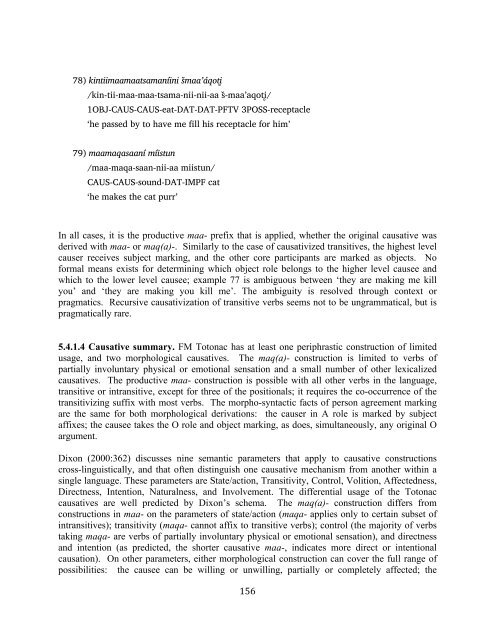The phonology and morphology of Filomeno Mata Totonac
The phonology and morphology of Filomeno Mata Totonac
The phonology and morphology of Filomeno Mata Totonac
You also want an ePaper? Increase the reach of your titles
YUMPU automatically turns print PDFs into web optimized ePapers that Google loves.
78) kintiimaamaatsamaníini s%maa’áqoti&<br />
/kin-tii-maa-maa-tsama-nii-nii-aa s"-maa’aqoti&/<br />
1OBJ-CAUS-CAUS-eat-DAT-DAT-PFTV 3POSS-receptacle<br />
‘he passed by to have me fill his receptacle for him’<br />
79) maamaqasaaní míistun<br />
/maa-maqa-saan-nii-aa miistun/<br />
CAUS-CAUS-sound-DAT-IMPF cat<br />
‘he makes the cat purr’<br />
In all cases, it is the productive maa- prefix that is applied, whether the original causative was<br />
derived with maa- or maq(a)-. Similarly to the case <strong>of</strong> causativized transitives, the highest level<br />
causer receives subject marking, <strong>and</strong> the other core participants are marked as objects. No<br />
formal means exists for determining which object role belongs to the higher level causee <strong>and</strong><br />
which to the lower level causee; example 77 is ambiguous between ‘they are making me kill<br />
you’ <strong>and</strong> ‘they are making you kill me’. <strong>The</strong> ambiguity is resolved through context or<br />
pragmatics. Recursive causativization <strong>of</strong> transitive verbs seems not to be ungrammatical, but is<br />
pragmatically rare.<br />
5.4.1.4 Causative summary. FM <strong>Totonac</strong> has at least one periphrastic construction <strong>of</strong> limited<br />
usage, <strong>and</strong> two morphological causatives. <strong>The</strong> maq(a)- construction is limited to verbs <strong>of</strong><br />
partially involuntary physical or emotional sensation <strong>and</strong> a small number <strong>of</strong> other lexicalized<br />
causatives. <strong>The</strong> productive maa- construction is possible with all other verbs in the language,<br />
transitive or intransitive, except for three <strong>of</strong> the positionals; it requires the co-occurrence <strong>of</strong> the<br />
transitivizing suffix with most verbs. <strong>The</strong> morpho-syntactic facts <strong>of</strong> person agreement marking<br />
are the same for both morphological derivations: the causer in A role is marked by subject<br />
affixes; the causee takes the O role <strong>and</strong> object marking, as does, simultaneously, any original O<br />
argument.<br />
Dixon (2000:362) discusses nine semantic parameters that apply to causative constructions<br />
cross-linguistically, <strong>and</strong> that <strong>of</strong>ten distinguish one causative mechanism from another within a<br />
single language. <strong>The</strong>se parameters are State/action, Transitivity, Control, Volition, Affectedness,<br />
Directness, Intention, Naturalness, <strong>and</strong> Involvement. <strong>The</strong> differential usage <strong>of</strong> the <strong>Totonac</strong><br />
causatives are well predicted by Dixon’s schema. <strong>The</strong> maq(a)- construction differs from<br />
constructions in maa- on the parameters <strong>of</strong> state/action (maqa- applies only to certain subset <strong>of</strong><br />
intransitives); transitivity (maqa- cannot affix to transitive verbs); control (the majority <strong>of</strong> verbs<br />
taking maqa- are verbs <strong>of</strong> partially involuntary physical or emotional sensation), <strong>and</strong> directness<br />
<strong>and</strong> intention (as predicted, the shorter causative maa-, indicates more direct or intentional<br />
causation). On other parameters, either morphological construction can cover the full range <strong>of</strong><br />
possibilities: the causee can be willing or unwilling, partially or completely affected; the<br />
! ")*!

















